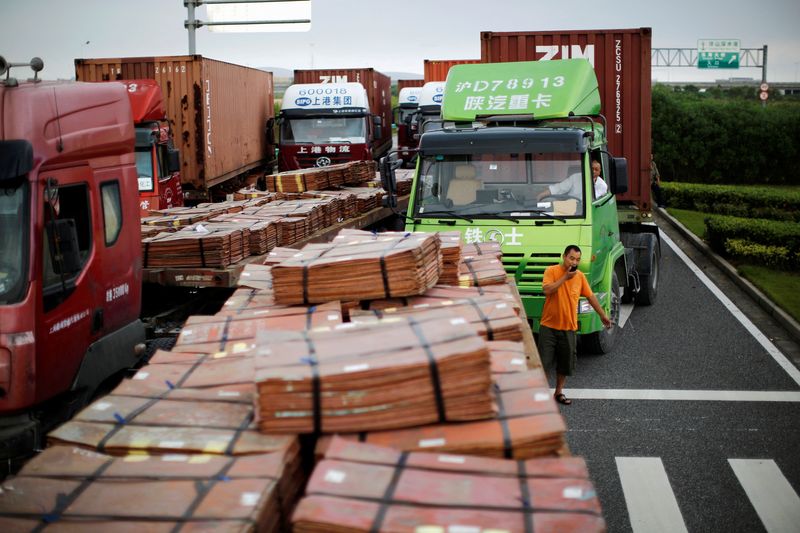(Reuters) – The Russian Copper Company (RCC) and Chinese firms dodged taxes and dodged the impact of Western sanctions by trading in new copper wire rod disguised as scrap, three sources familiar with the matter told Reuters.
The sources said copper wire rod in the remote Uyghur region of Xinjiang was shredded by a middleman to make it harder to distinguish from scrap, allowing both exporters and importers to benefit from the different tariffs on scrap and virgin metal, the sources said.
The Russian export tariff on copper wire rod was 7% in December, lower than the 10% levy on scrap. The import of copper wire rod into China is taxed at 4%, and no duty is charged on scrap imports from Russia.
The sale of virgin metal disguised as scrap that began in December is reflected in a discrepancy between Chinese and Russian data.
Chinese customs data showed China has bought significantly more copper scrap from Russia since December, while Russian figures obtained by Reuters from a commercial data provider showed the amount of scrap exported to the country’s largest trading partner was negligible.
Responding to a Reuters query about the discrepancy, Russian Customs said: “The Federal Customs Service is temporarily not providing data on foreign trade.” The publication of trade data stopped in April 2022, shortly after Russia’s invasion of Ukraine. Since then, the market has been dependent on commercial providers.
When asked about trading copper wire rod to Chinese companies, RCC, which is subject to Western sanctions, said it supplies products only to Russian companies. No further comment was made.
Chinese customs in Xinjiang, which borders Russia, did not respond to an email query or a phone call.
China has become a major destination for Russian companies looking to export their goods after the United States imposed sanctions on Russia in February 2022 over its invasion of Ukraine.
The United States and the European Union have imposed sanctions on Chinese companies for supporting Russia’s war effort in Ukraine.
FAIRING
Shredding newly manufactured copper wire rod is an effective way to mask new material that looks very different from scrap.
The new long, thin rods of high-purity copper, used primarily for making power cables, are typically rolled up for ease of transportation.
Copper scrap, on the other hand, is a mixture of wires, pipes and pipes that have already been used. For transport, they are cut into grain-sized pieces or rolled up and pressed like pasta packets.
The extermination went unnoticed because China restricted access to the Xinjiang region in response to international condemnation of the repression of the Uyghurs, the sources said.
Aside from the financial incentive of avoiding taxes, the shredded metal is harder to identify and trace – making it easier to sell to Chinese manufacturers.
In theory, there are no legal barriers preventing China from buying metal from Russian companies under Western sanctions. Nevertheless, manufacturers could be wary of losing their export business to buyers who do not want to provide funds to Russia.
Sanctions can also mean difficulties in processing payments and obtaining credit. According to the sources, some Chinese companies have formed new teams to handle Russian-related business.
“DE FACTO COPPER ROD”
According to a commercial data provider, Chinese companies purchased a total of five products called “copper wire” from the RCC plant in the Urals region last December. According to the commercial data provider, purchases by a United Arab Emirates-based company called Modern Commodity Trading DMCC generated about $65 million in sales.
The United Arab Emirates-based company could not be reached for comment.
Russia has never been a big seller of copper scrap to China.
However, China’s copper scrap imports from Russia increased significantly since December last year, customs data showed.
The bulk of it, 97% or 6,434 tons, came across the Alashankou border in Xinjiang in December.
Russian data showed a discrepancy, suggesting the country sold only 73 tonnes of copper scrap to China in the same month.
In 2021 and 2022, an average of 95.3 tons and 125 tons of Russian copper scrap were sold to China each month, respectively.
Volumes have increased sharply in recent months and monthly imports reached 11,599 tons by February 2024.
Customs data on Chinese imports of copper wire rod is not publicly available.
“This scrap from Russia is de facto copper rod, but it was not declared as a rod. I cannot reveal any further details,” said a Chinese production source who wished to remain anonymous. The source added that the material could be consumed directly by copper producers in Jiangsu and Zhejiang provinces.
While Russian data showed minimal scrap exports, there was a sudden increase in wire rod exports in December.
According to the data, Kyshtym Copper Electrolyte Plant JSC, a facility operated by RCC, shipped 8,041 tons of copper wire rod to China via Alashankou in Xinjiang in December, compared to just 1,618 tons in November.
“As of today, the Kyshtym Copper Electrolyte Plant sells its products only to domestic companies,” the Kyshtym plant said in a response to Reuters questions about its sales to China.
“We have not monitored the further whereabouts of the products, so I have nothing to add to what has already been said.”
(This story has been re-archived to correct the spelling of “Uygur” to “Uyghur” in paragraphs 2 and 14.)
(Reporting by Reuters reporters; Editing by Veronica Brown and Barbara Lewis)
